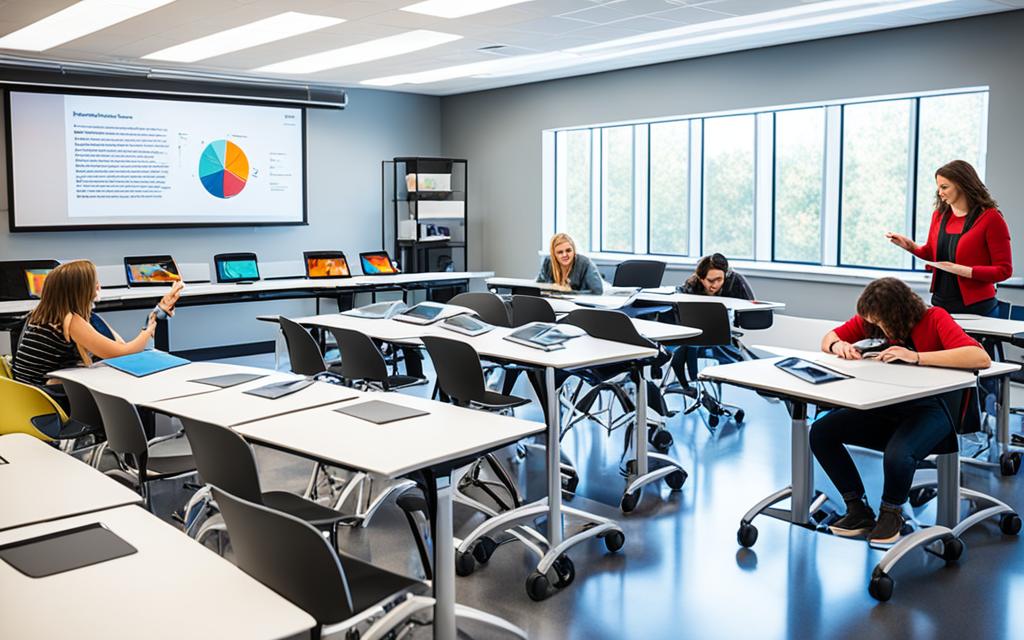In the world of education, new tech has changed everything. It has made learning personal, fun, and better for everyone. Education technology is not just about making things easier—it also keeps us safe from online threats.1
The FCC has opened a program to help schools and libraries stay safe against cyberattacks. They’re putting $200 million over three years into this. The goal is to protect students and teachers so they can use tech safely. Now, keeping track of devices well is very important for schools.1
Using the right tracking and managing tools, schools can run smoother. They can take better care of their tech. This means teachers can use exciting tools like digital classroom solutions and e-learning platforms in new ways. Plus, students get to experience virtual reality in education and adaptive learning in a safer, better environment.1
Key Takeaways
- The Federal Communications Commission has approved a $200 million Cybersecurity Pilot Program to protect schools and libraries from cyberattacks.
- Efficient device management and real-time resource allocation are essential for maximizing the impact of education technology innovations.
- Advanced tracking systems and comprehensive device management strategies can streamline operations, improve maintenance, and guide technology investments.
- Embracing innovative digital classroom solutions and e-learning platforms empowers educators to deliver personalized, immersive, and adaptive learning experiences.
- Securing the technology infrastructure is crucial for harnessing the transformative potential of education technology advancements.
Embracing the Future of Edtech
Education is changing fast, thanks to new tech. AI-powered learning, virtual reality education, and gamification in the classroom are leading the way. They’re making learning more personal, fun, and real.
AI-Powered Learning Experiences
AI is changing how we learn, giving each student a unique path.2 It uses smart machines to help grade work quickly and offer custom tips. This helps students do their best.
Virtual Reality Education
Imagine learning in a make-believe world. That’s what virtual reality does.2 It puts students in lifelike situations. They can practice what they know in a safe place.
Gamification in the Classroom
Games are being used to make learning fun.
Gamification in the classroom includes fun challenges and rewards. And it boosts teamwork. Teachers use this to grab students’ interest and make lessons stick.
These new tools are changing how we learn, for both students and teachers.2 They offer personal, engaging ways to study. Keep watching as education gets even more exciting.
Adaptive Learning Platforms
Adaptive learning platforms are changing how lessons are taught and learned. They use special math and computer science. This helps make studying fit each student’s own way of learning. This is done by watching each student’s progress and changing the lessons to match what they need.4 This way, students get to learn in a way that’s just right for them, making learning fun, faster, and better.5
Personalized Learning Pathways
These platforms look at what each student knows and then gives them lessons at their level. They keep an eye on how well everyone is doing and what they’re interested in, too. This makes sure every student gets lessons that are just right for them.4 Because of this, students can learn when they’re ready, helping them be their very best.5
Real-Time Student Progress Tracking
Adaptive learning tools use data to help teachers see how well their students are doing. They catch problems right away and can give extra help where it’s needed. Because they use a lot of student data, they keep getting better at helping students learn.4

Online Collaborative Tools
Online collaborative tools are now key for student interactivity and team efforts. They provide a space for digital group work, helping with communication and problem-solving skills. These are very important in today’s work world, where many tasks are done online.6
Enhancing Student Engagement
These tools make student teamwork easier and more real-time, even in remote learning. Students can edit shared documents together. Plus, they can have interactive discussions and annotations, which makes them feel seen and involved.7 It can also help with independent learning, as students talk and share with each other. This leads to deeper engagement with their lessons.7
Fostering Virtual Teamwork
Virtual teamwork skills are vital for the digital work world. Online tools prepare students for this reality by offering text, file, and picture sharing, plus video calls. These activities help develop important team skills.8 Employers really value workers who can collaborate well.8 Thus, experiences with online teamwork prepare students for future success in their careers.
Educational Data Analytics
Educational data analytics change how schools help students succeed. They use data from digital tools to track each student’s progress.9 Teachers get insights into each student’s strengths and weaknesses. This helps them offer the right support early, preventing anyone from falling behind.10
Insights into Student Performance
Educational data analytics help educators know more about student progress.10 They track things like student involvement and effective teaching methods. This lets teachers personalize their lessons, making sure every student can learn well.
Identifying Learning Gaps
These analytics are also key in finding and fixing learning gaps.10 They show where students struggle, so teachers can focus their help where it’s needed most.9 By using this data, schools can better support students, ensuring everyone has a chance to excel.
The use of data analytics is vital for today’s teaching.11 It’s essential for personalized learning and better academic results. Data helps make education fairer and more open for all.10 This new tool is transforming education and creating more opportunities for students to do well.

Innovations in Education Technology
The way we learn and teach is rapidly changing. New technologies are at the forefront. They help students excel and teachers provide more effective lessons. Technologies like AI-powered tutoring and virtual reality are taking education to new heights.12
AI-Powered Tutoring
AI-powered tutoring offers personalized learning. It gives each student tailored help, feedback, and practice. The use of advanced algorithms and data analytics make this possible. These systems aim to help every student achieve their best.1213
Virtual Reality Simulations
Virtual reality (VR) puts students inside learning experiences. They can interact with subjects in a realistic, hands-on way. This makes learning more engaging and memorable. As VR tech gets better, it will be key in many classrooms. It will allow students to explore subjects like never before.1213
The introduction of these tech advancements changes the education scene. AI, VR, and other tools make lessons more personal and engaging. They help prepare students for the future. This shows how the learning experience is always improving with new tech.1213
Digital Classroom Solutions
The modern classroom is changing fast, thanks to digital tools. These tools are making teaching fun and effective in new ways, especially after the pandemic. Now, teaching with innovative methods and using new tech is more important than ever.14
Interactive Whiteboards
Interactive whiteboards are changing lessons for the better. They let teachers mix in videos and drawings in real-time. Also, they make group discussions exciting and easy.15 Reports show that these digital tools are enhancing education quality and making it more available.15
E-Learning Platforms
Online learning means a wealth of digital resources. Students can learn with videos, do fun quizzes, and complete tests online. This way, every student can learn in a way that suits them best.14 The pandemic has shown how tech can bring students and teachers closer in remote learning. It’s about adapting together to new ways of learning.14
Digital classroom solutions are changing education as we know it. They’re making learning interactive, fun, and personalized. But, to make this work for everyone, we need affordable gadgets and strong internet everywhere.15

E-Learning Platforms
E-learning is now more important than ever for remote and hybrid learning. It offers tools for great learning experiences away from the classroom. These platforms lead to better remote learning with live video calls, lesson materials to use on your own time, and places to work together.16 They also give you access to lots of ways to learn, like virtual labs and videos. This helps students learn in many fun and effective ways.16
Enhancing Remote Learning
Now, e-learning is a key part of how we learn from a distance. It has features that make learning easy and fun, even if you’re not in the same place. Because of things like video calls and shared spaces to work, everyone can join in and learn together.16
Multimedia Educational Resources
E-learning lets students dive into many kinds of learning materials. You can try virtual experiments, watch videos, or use fun presentations to learn. All these different methods make learning more interesting and help you remember better.16 These tools also let you learn the way you like best. They offer a variety of resources for everyone’s unique learning style and needs.16
| Key E-Learning Platform Features | Benefits to Learners |
|---|---|
| Live Video Conferencing | Facilitates real-time collaboration, discussion, and interactive learning |
| Asynchronous Lesson Materials | Enables flexible, self-paced learning and access to content on-demand |
| Collaborative Workspaces | Promotes teamwork, communication, and problem-solving skills in virtual settings |
| Multimedia Resources | Enhances engagement, understanding, and retention through interactive simulations, virtual labs, and engaging presentations |
Emerging Trends in Edtech
The world of education technology is always changing. New trends are guiding how we learn in the future.17 Virtual reality (VR) is becoming a popular tool in education. It lets students step into digital worlds, making learning more fun and hands-on. The global market for VR in education was $4.4 billion in 2023. Experts predict it will grow to $28.7 billion by 2030, showing big potential for its use.
VR and augmented reality (AR) will be key in online schools up to 12th grade. They bring lessons to life and help students understand tough topics better.
Virtual Reality in Education
17 Technology like AR and VR is making learning more real. It lets students do things like go on virtual field trips or speak in a new language in a virtual world.18 With these tools, learning is not just in books. Students can visit important places or explore the universe. They can also practice real-world skills in different jobs. This way, they learn in more fun and practical ways.
Educational Apps and Games
17 Turning learning into games is a big hit right now. It’s called gamification, and it makes learning more interesting. Students get more involved in their lessons.19 It’s great at keeping students interested and motivated. This approach works for all kinds of lessons and can be used in many apps.
18 By adding game-like challenges and rewards, education becomes more tailored and fun for today’s tech-savvy students.

Conclusion
The world of education tech is changing fast, bringing new tools that make teaching and learning better.20 It’s changing how students learn, making it more accessible, fun, and tailored to each student.21 Between 2019 and 2020, public school student numbers dropped, and more families started homeschooling. Now, 3.7 million students are learning from home in the USA.21
New tech like AI learning and virtual reality are changing the game, making education more personal and engaging.20 These tools ignore distances, bringing education to everyone, no matter where they live. They also give students more control over what and how they learn.
Schools are getting on board with these changes, making sure students get the best education for tomorrow’s world.21 There are over 3 million teachers in public schools, showing how much we invest in learning. Almost every classroom has internet now, and teachers got better at using tech during the pandemic.21
FAQ
What is the Schools and Libraries Cybersecurity Pilot Program?
How can advanced tracking systems help schools manage their technology more efficiently?
How are AI-powered learning experiences transforming education?
What are the benefits of virtual reality education?
How can gamification in the classroom benefit students?
How do adaptive learning platforms personalize the learning experience?
What are the benefits of online collaborative tools in education?
How can educational data analytics improve learning outcomes?
How are AI-powered tutoring systems transforming education?
What are the benefits of digital classroom solutions?
How are e-learning platforms enhancing remote and hybrid learning?
What are some emerging trends in education technology?
Source Links
- https://www.edtechupdate.com/
- https://www.linkedin.com/pulse/embracing-future-education-2023-trends-innovations-campuzone
- https://cxotoday.com/story/embracing-the-future-how-technology-is-revolutionizing-education
- https://pratikmistry.medium.com/embracing-the-tech-revolution-in-education-adaptive-learning-fbd2354f759b
- https://siliconvalley.center/blog/revolutionizing-education-the-power-of-adaptive-learning-platforms
- https://sunbytes.io/online-collaboration-tools-for-educators-and-students/
- https://www.smartbrief.com/original/student-stress-edtech-tools
- https://www.rocket.chat/blog/student-collaboration-tools
- https://www.ucats.org/innovations-in-educational-technology-and-classroom-integration.html
- https://elearningindustry.com/is-data-analytics-and-data-analytic-trends-important-reshaping-edtech-industry
- https://www.sganalytics.com/blog/data-analytics-trend-in-edtech-industry/
- https://www.theamegroup.com/top-6-technology-innovations-education/
- https://meetaverse.com/blog/top-innovations-in-education/
- https://marketscale.com/industries/education-technology/educational-technology-innovations-beyond-classroom-walls
- https://www.forbes.com/sites/forbestechcouncil/2024/02/01/technology-driven-education-a-new-era-of-learning
- https://elearningindustry.com/evolution-of-elearning-trends-and-innovations-shaping-the-industry
- https://powergistics.com/education-technology-trends/
- https://www.avixa.org/pro-av-trends/articles/5-emerging-trends-in-education-tech-for-2024
- https://www.forbes.com/sites/forbesbusinesscouncil/2024/02/22/four-emerging-trends-in-edtech-in-2024/
- https://www.eschoolnews.com/it-leadership/2023/12/11/the-impact-of-technology-on-education/
- https://www.thepolicycircle.org/brief/innovation/
